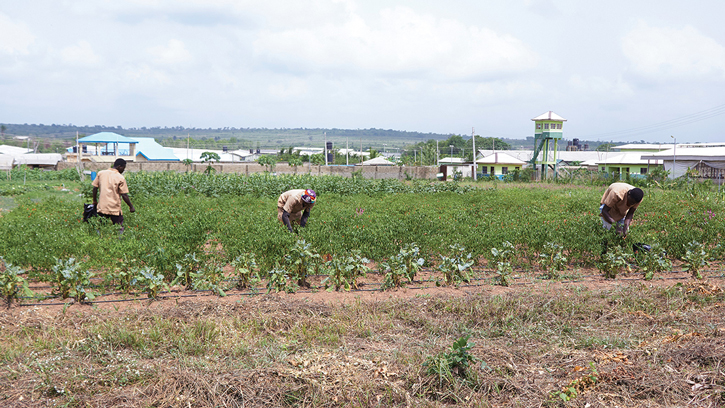Creating Food Processing Opportunities in Nigeria
PROCESSING
This month’s Processing column will take the reader to Africa and open the window to understanding Nigeria and food processing challenges and opportunities there. Thanks are due to the coauthor of this column, Oladayo Buliameen, chief operating officer for D-Marine and Business Networks, an innovative specialty food processor in Niger State, Nigeria.
On a Growth Track
Nigeria has undergone tremendous growth in recent years. The population in 1900 was 119 million; by 2020, it had grown to 206 million, according to United Nations data. During that time period, the urban population grew from 31% to 52%, and the middle class grew from fewer than one million to 50 million. By 2050, the population is expected to reach 411 million, with 67% dwelling in urban areas and the middle class totaling 120 million.
With almost 100 million people actively involved in subsistence farming and contributing 21% of the GDP, Nigeria is a quintessential agrarian economy with slowly developing food manufacturing and service sectors. Nigeria is also one of the top resource-rich countries of the world and suffers from tragic underutilization of resources in excess of 40% (CIA 2020). In addition to abundant minerals and natural and human capital resources, Nigeria is blessed with enormous agricultural resources and an ideal climate for agriculture. Arable land accounts for about 90% or 82 million hectares of the total 91 million hectares of land in Nigeria, of which less than 42% (34 million hectares) is presently being cultivated. This land is cultivated mostly by smallholder farmers.
The large numbers of farmers in Nigeria churn out fairly modest harvests in grains and perishable fruit and vegetables. At the same time, the primary and secondary value chains for postharvest storage, handling, and processing are low or nonexistent in most cases.
Postharvest Primary Processing Challenges
Because an organized infrastructure for efficient and effective postharvest handling and storage (modern silos, cold chains, etc.) is lacking, a significant share of annual cereal and grain outputs is lost. In many cases, excessive amounts of preservatives are used, and residues exceed the 20 ppm threshold set by the World Health Organization. Vital primary processing facilities, such as industrial grain dryers and large-scale automatic grain sorting machines, are not available to help process the smallholder farmers’ raw grains and cereal outputs. These processing steps are much needed in order to meet the quality expectations of increasingly sophisticated Nigerian consumers and manufacturers, as well as for export markets.
Grain and cereal outputs from these small farmers often contain pebbles and foreign materials that present serious challenges in sorting for small-scale packaged food manufacturers, who frequently lack sufficient funds to invest in extra sorting machinery. This lack of basic sorting technologies results in many consumers opting to purchase stone-free imported processed foods instead of Nigerian processed foods.
In addition, common practices by smallholder farmers, such as spreading grains on the ground for sun drying, exposes these locally processed foods to foreign materials and unpredictable rain showers, which result in high-moisture grains and inadvertent mold infestations. Thanks to the combined effect of an undeveloped food processing and manufacturing system, as well as a myriad of primary processing challenges, Nigeria is a net importer of food despite its high number of small farmers (PWC 2019).
Postharvest Secondary Processing Challenges
Less than 5% of grains and cereals end up as postharvest losses in Nigeria, while more than 40% of fruits and vegetables end up as postharvest losses (Ubochi 2018). These include staple vegetables such as tomatoes, plantains, potatoes, oranges, and pineapples. This loss is the equivalent of $9 billion annually in Nigeria (AgroNigeria 2017). At the same time, fewer than 3% of the 150 million consumers in Nigeria who wish to consume more fruits and vegetables have regular access to them.
Processed foods are becoming more of a normal part of life in Nigeria thanks to factors that include rapid urbanization (a rate of 4.2% annually), a higher level of literacy that translates into rising income levels, rapidly increasing general population growth, and an even faster middle-class growth rate. In 2012 Nigeria’s processed food industry was valued at $20 billion annually and is expected to grow by several tens of billions of dollars by 2050 (USDA 2013). This growth projection does not account for the immediate West African sub-Saharan region with a population of about 200 million and the overall influences of Nigerian lifestyles on other sub-Saharan African countries.
Despite this huge available market for processed, ready-to-eat foods (meals, snacks, and beverages), this industry remains highly underdeveloped. Most of these food processing companies offer only standard or conventional food products (mostly beverages, biscuits, and instant noodles) that are tailored to general global consumers with little or no consideration (or formulations) for the African or local palate.
This gap has created huge business opportunities for thousands of micro and small entrepreneurs in Nigeria. Since the early 2000s, using low-technology food processing unit operations, (such as efficient tray drying, ovens, deep fryers, and small bottling lines), trained Nigerian small business entrepreneurs have begun processing and packaging shelf-stable foods (mostly snacks and beverages) that are tailored to the African palate. Further advances to harness the full potential of this burgeoning industry, which offers great promise for financial returns, national productivity, and employment, are being hampered by one or a combination of the following critical gaps: lack of knowledge, lack of copackers, and lack of capital.
Knowledge Gaps
To be able to move beyond simple processing, using basic operations of drying, baking, roasting, and frying to preserve foods and efficiently process and pack mainstream consumer products with high nutritional contents, Nigerian entrepreneurs need real-time, hands-on processing experience using modern, high-tech equipment.
It’s true that Nigeria, like other sub-Saharan African countries, has a number of universities and polytechnic institutions offering degrees and programs on food science and technology; however, these programs provide mostly theoretical training rather than hands-on experience. In addition, the majority of these institutions are severely financially handicapped and unable to purchase food processing equipment for laboratory or pilot plant training purposes in preparation for industrial scale-up. For instance, as old as canning technology is, most Nigerian undergraduate degree programs do not provide any hands-on experience with canning.
Nigerian food entrepreneurs need key practical knowledge in a wide range of processing technologies, including but not limited to aseptic processing and packaging, commercial enzyme production, starch and sucrose hydrolysis, pure protein and active compound extractions, forming, and extrusion processes. This type of training will help in bringing real value to Nigerian-grown raw materials that currently are not utilized or are exported raw to other countries for processing. Value-added processing is much needed in order for Nigeria to support future economic growth. Like the popular saying that “a picture is worth a thousand words,” hands-on food processing training is the path toward Nigerians making significant contributions to global food security and development.
A Country Without Copackers
There are no small-batch food copackers in Nigeria that could help visionary food entrepreneurs co-manufacture products and prove their concept in order to gain market traction. This is a serious challenge that leaves small entrepreneurs stuck with their ideas because they lack sufficient capital to invest in startup fixed assets such as processing lines. The culture of commercial kitchens and food copackers in the United States, Europe, China, and other countries enables small entrepreneurs to scale up very quickly. This type of infrastructure is needed in Nigeria.
Lack of Capital
Most currently successful Nigerian entrepreneurs rely on low-technology businesses that are relatively affordable. However, for more advanced processing solutions, Nigerian food processors are financially incapacitated. Unlike in the United States or Europe, in Nigeria, there is not a funding ecosystem comprised of grants, angel investors, and venture capitalists to approach for seed capital funding for promising new food products and business models. The only funding options available are traditional bank loans, with interest rates close to 30%; government-owned development bank funding is not reliable.
Nigeria is a country of tremendous resources to support innovative and lucrative food processing opportunities. Increased financial investment in small businesses, hands-on training for entrepreneurs, and development of copacking facilities would help transform the food processing landscape of this African country during the years ahead.
REFERENCES
AgroNigeria. 2017. “Nigeria loses $9bn to post-harvest losses.” https://agronigeria.ng/2017/09/25/nigeria-loses-9bn-post-harvest-losses-fiiro/.
CIA. 2020. Central Intelligence Agency Factbook. https://www.cia.gov/library/publications/the-world-factbook/geos/print_ni.html.
PWC. 2019. “Unlocking Nigeria’s Agricultural Exports.” PricewaterhouseCoopers. https://www.pwc.com/ng/en/assets/pdf/unlocking-ngr-agric-export.pdf.
Ubochi, S. 2018. “Nigeria Just Keeps Wasting Their Resources as They Don’t Have Any Means of Preserving It.” Naija Flake, July 15. http://www.naijaflake.com/2018/07/nigeria-losses-40-of-harvest-on-fruits.html.
USDA. 2013. Nigeria Food Processing Ingredients Market. U.S. Dept. of Agriculture Foreign Agricultural Service. https://www.fas.usda.gov/data/nigeria-food-processing-ingredients.






